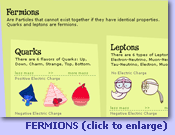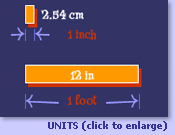

 |
Fermion |
All fundamental particles can be classified as either bosons or fermions. Particles have lots of different properties, such as electric charge and spin. Fermions are particles that cannot exist together if they have identical properties. Quarks and leptons are fermions and so can only group together if some property they have is different from each other. Bosons are particles that can group together even if they have exactly identical properties. click to enlarge image. |
 |
Fluorescence |
The release of energy that has been absorbed by electrons in the form of light particles or photons. |
 |
Foot |
A foot (ft) is a unit of length equal to 12 inches. |
 |
Force |
When you push or pull on something, there is a force. There are forces in nature that can influence particles including: gravity, electromagnetic, weak, and strong. |
Fossil Fuel |
|
 |
|
Fuel derived from the decomposition and fossilization of dead organisms. Examples include coal, petroleum or oil, and natural gas. Fossil fuels are non-renewable. |
|
 |
Fuel |
Material that is burned to transform potential energy in the form of chemical bonds into kinetic energy. Examples include oil, coal, wood, as well as food. |
Fundamental Particles |
|
These are the smallest things in nature that scientists know of. So far, no-one has been able to split them into smaller pieces. Everything else is made of combinations of these particles. see the Fundmental Particles Chart |
